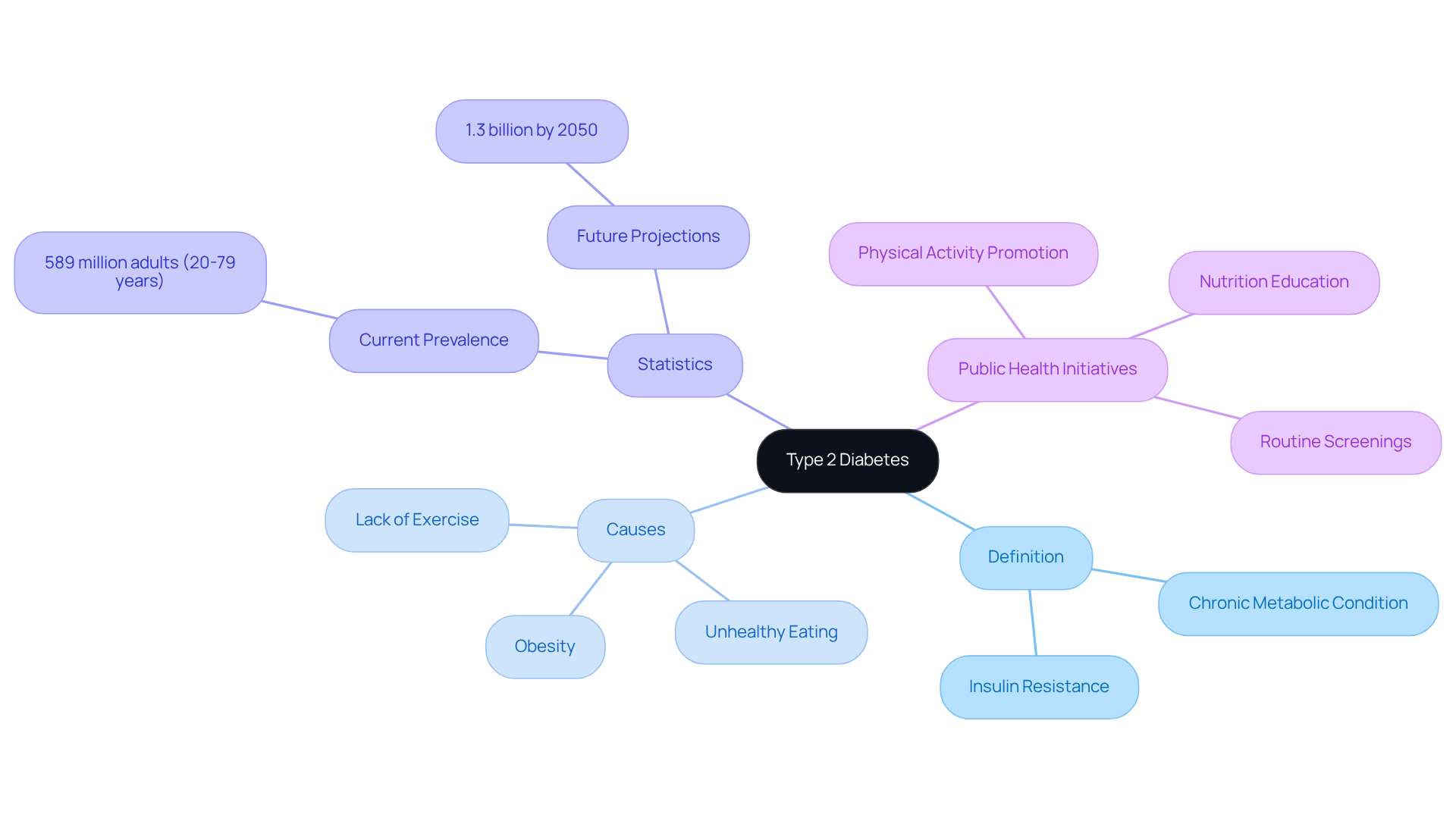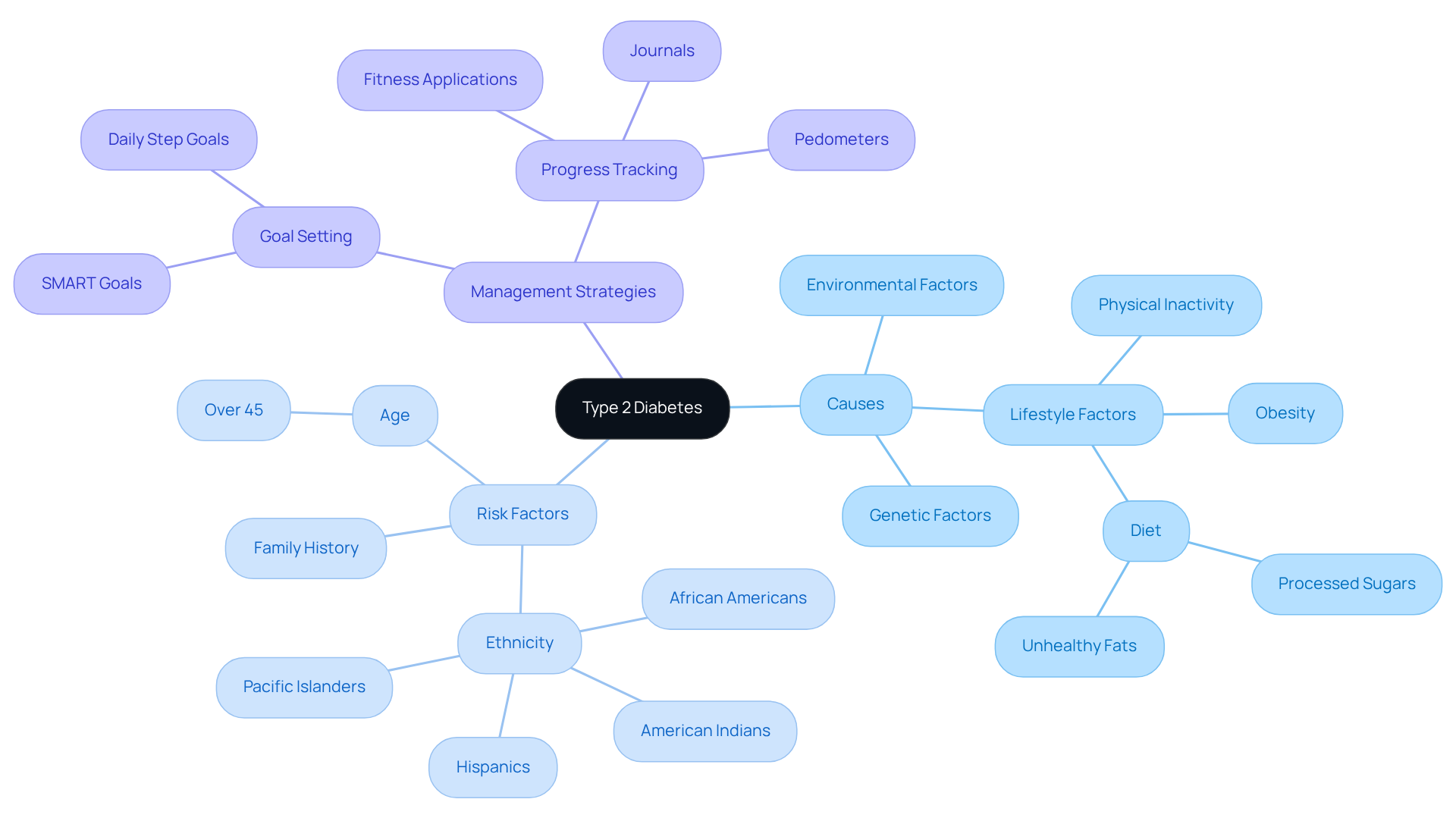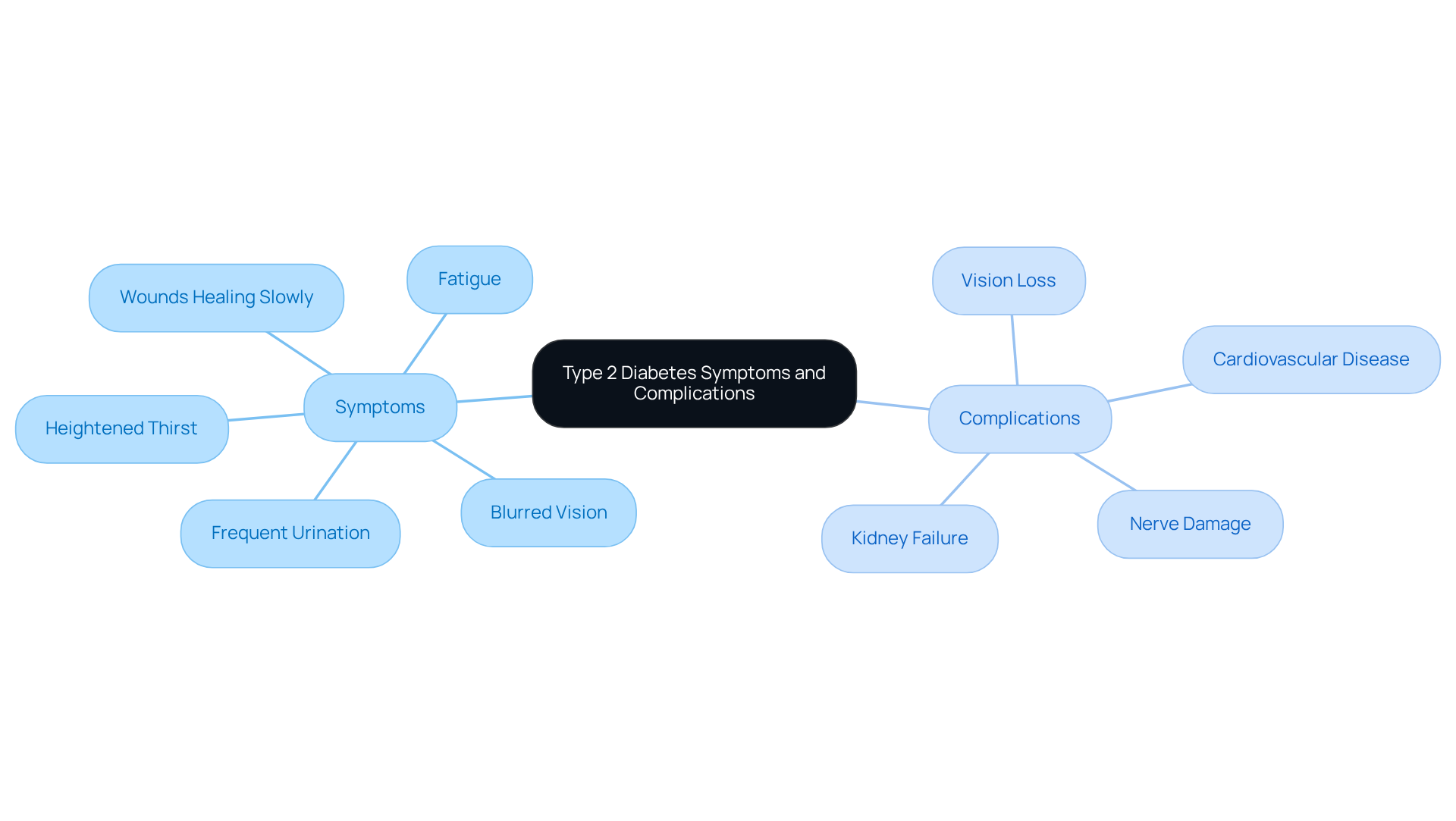Overview
Type 2 diabetes can feel overwhelming, primarily caused by insulin resistance, which is often linked to lifestyle factors like obesity, lack of exercise, and unhealthy eating habits. This condition leads to elevated blood glucose levels, and it’s important to recognize that many individuals are navigating these challenges daily. Understanding the roots of Type 2 diabetes is crucial, as it allows us to address the emotional and physical toll it takes on lives.
As we delve deeper, we see the rising prevalence of this condition, projected to exceed 1.3 billion affected individuals by 2050. This statistic highlights an urgent need for community awareness and proactive health strategies. Together, we can combat this growing concern through supportive public health initiatives that resonate with those impacted.
Imagine the difference we can make when we foster an environment of understanding and compassion. By encouraging healthy living through programs like the 30-Day Diabetes Reset, we can empower individuals to take charge of their health. Remember, you are not alone in this journey, and there are steps we can take together to create a healthier future.
Introduction
Type 2 diabetes represents a growing health crisis, affecting nearly 589 million people globally. Projections indicate this number could soar to over 1.3 billion by 2050. It’s important to recognize that understanding the nuances of this condition is crucial, not only for personal health but also for the broader implications on community well-being and economic stability. As lifestyle factors like obesity and inactivity continue to rise, many individuals may feel overwhelmed by the challenge.
How can we effectively combat this epidemic before it spirals further out of control? Together, we can explore ways to foster healthier habits and support one another in this journey.
Define Type 2 Diabetes: Understanding Its Nature and Importance
Type 2 hyperglycemia is a chronic metabolic condition that many people face, characterized by insulin resistance. This means the body struggles to effectively utilize insulin, leading to elevated blood glucose levels. Unlike the first type, where the body cannot produce insulin at all, type 2 typically develops slowly and is often linked to lifestyle factors such as obesity, lack of exercise, and unhealthy eating habits. It’s important to recognize that this condition is the most common worldwide, affecting around 589 million individuals aged 20 to 79. If not addressed, it can pose significant risks to well-being, including cardiovascular illness, kidney failure, and neuropathy.
Understanding the meaning of type 2 diabetes is essential not just for personal health but also for the wellness of our communities and economies. The World Health Organization has pointed out that the global prevalence of this condition has risen dramatically. By 2050, projections suggest that the number of affected adults could exceed 1.3 billion. This alarming trend highlights the urgent need for effective public health initiatives aimed at prevention and management.
Health experts emphasize the importance of addressing the root causes of type 2 diabetes to fully understand the meaning of type 2 diabetes rather than merely managing its symptoms. As Dr. Tedros Adhanom Ghebreyesus, WHO Director-General, has noted, the rise in diabetes correlates with increases in obesity, unhealthy food marketing, and a lack of physical activity. Many patients find that public health initiatives promoting healthy lifestyles, early diagnosis, and access to care are vital in combating this epidemic.
Real-world examples of successful public health initiatives include community-based programs focusing on nutrition education, physical activity promotion, and routine medical screenings. These initiatives have shown promise in reducing the incidence of type 2 diabetes and improving health outcomes for those affected. By fostering a deeper understanding of the meaning of type 2 diabetes, individuals and communities can take proactive steps toward its prevention and management, ultimately leading to better health and lower healthcare costs.
If you’re seeking personalized assistance and support tailored to your specific needs, consider reaching out to Dr. Jason Shumard, D.C. He has extensive credentials in functional medicine and is dedicated to helping patients manage and even reverse their condition effectively.
Identify Causes and Risk Factors: Who is Affected by Type 2 Diabetes?
The onset of type 2 diabetes can feel overwhelming, influenced by a complex interplay of genetic, environmental, and lifestyle factors, which contributes to the overall meaning of type 2 diabetes. Many individuals struggle with obesity, particularly central obesity, which significantly elevates insulin resistance. Physical inactivity and poor dietary choices, especially those rich in processed sugars and unhealthy fats, can further heighten the likelihood of developing this condition. It’s important to recognize that age plays a crucial role, with individuals over 45 facing a heightened risk. Additionally, a family history of sugar-related conditions, certain ethnic backgrounds—including African Americans, American Indians, and Hispanics—and concurrent medical issues such as hypertension and high cholesterol can increase vulnerability. Understanding these elements is essential for adopting proactive strategies to oversee well-being and reduce the likelihood of developing the meaning of type 2 diabetes. Recent studies indicate that approximately 38.4 million Americans had diabetes in 2021, highlighting the urgent need for awareness and intervention strategies.
To effectively manage their condition, patients are encouraged to implement strategies for progress tracking and goal setting. Utilizing tools such as fitness applications, journals, and pedometers can help individuals track their wellness journey. Setting SMART goals—specific, measurable, attainable, relevant, and time-bound—can significantly enhance focus and motivation. For instance, many patients find that aiming to achieve 10,000 steps daily or gradually increasing exercise duration leads to improved health outcomes. Research indicates that organized goal-setting can result in improved performance and accountability, which is essential for individuals overseeing their health.
Moreover, it is crucial to recognize the dangers of traditional treatments for blood sugar management, which may inadvertently increase insulin resistance. By prioritizing comprehensive care and understanding the risks associated with these treatments, patients can better navigate their wellness journey and work towards understanding the meaning of type 2 diabetes. Remember, you are not alone on this journey, and with the right support and strategies, positive change is within reach.
Recognize Symptoms and Complications: The Impact of Type 2 Diabetes on Health
It’s important to recognize that the signs of this metabolic disorder often develop gradually, which contributes to the meaning of type 2 diabetes. You might notice heightened thirst, frequent urination, fatigue, blurred vision, and wounds that take longer to heal. Many individuals, perhaps like yourself, may overlook these symptoms until they escalate into more serious complications. If left untreated, the meaning of type 2 diabetes can lead to severe health issues, including:
- Cardiovascular disease
- Nerve damage
- Kidney failure
- Vision loss
In fact, this condition is a leading cause of new cases of blindness among adults aged 18-64, which can have profound implications for your quality of life.
The economic burden is also significant; in 2022, the total cost of diagnosed diabetes in the U.S. reached approximately $412.9 billion. This highlights the financial strain not only on healthcare systems but also on individuals like you. Therefore, recognizing these symptoms early and seeking appropriate medical advice is crucial for effective management and prevention of complications.
Many patients find that timely intervention can significantly reduce the risk of these long-term complications. This, in turn, can lead to improved patient outcomes and a better quality of life. Remember, you are not alone in this journey, and taking proactive steps can make a difference. Seeking support and guidance is a vital part of your path to healthier living.
Conclusion
Type 2 diabetes represents a significant public health challenge, characterized by the body’s inability to effectively use insulin, leading to elevated blood sugar levels. This condition is not only prevalent but is also intricately linked to lifestyle choices. It’s important to recognize that understanding its implications for individual health and societal well-being is crucial. By acknowledging the importance of type 2 diabetes, individuals and communities can take proactive measures to combat its rise and improve overall health outcomes.
Many patients find that key insights into type 2 diabetes reveal its multifaceted nature, including causes such as:
- Obesity
- Sedentary lifestyles
- Genetic predispositions
The critical need for preventive strategies, early diagnosis, and public health initiatives that promote healthier living cannot be overstated. Furthermore, recognizing the symptoms and potential complications of this condition can empower individuals to seek timely medical intervention, thereby reducing the risk of severe health issues and enhancing quality of life.
Ultimately, fostering awareness and understanding of type 2 diabetes is essential not just for those directly affected but for society as a whole. As the prevalence of this condition continues to rise, it is imperative to advocate for healthier lifestyles, support community-based programs, and prioritize education on diabetes management. By taking collective action, the impact of type 2 diabetes can be mitigated, leading to healthier individuals and communities. Remember, every small step toward a healthier lifestyle counts, and together we can make a difference.
Frequently Asked Questions
What is type 2 diabetes?
Type 2 diabetes is a chronic metabolic condition characterized by insulin resistance, where the body struggles to effectively utilize insulin, leading to elevated blood glucose levels.
How does type 2 diabetes differ from type 1 diabetes?
Unlike type 1 diabetes, where the body cannot produce insulin at all, type 2 diabetes typically develops slowly and is often linked to lifestyle factors such as obesity, lack of exercise, and unhealthy eating habits.
How common is type 2 diabetes worldwide?
Type 2 diabetes is the most common form of diabetes worldwide, affecting around 589 million individuals aged 20 to 79.
What are the potential risks of untreated type 2 diabetes?
If not addressed, type 2 diabetes can pose significant risks to well-being, including cardiovascular illness, kidney failure, and neuropathy.
Why is understanding type 2 diabetes important?
Understanding type 2 diabetes is essential for personal health as well as the wellness of communities and economies, especially given the rising global prevalence of the condition.
What are the projections for type 2 diabetes prevalence by 2050?
Projections suggest that by 2050, the number of affected adults could exceed 1.3 billion.
What factors contribute to the rise of type 2 diabetes?
The rise in type 2 diabetes correlates with increases in obesity, unhealthy food marketing, and a lack of physical activity.
What role do public health initiatives play in combating type 2 diabetes?
Public health initiatives that promote healthy lifestyles, early diagnosis, and access to care are vital in combating the epidemic of type 2 diabetes.
Can you provide examples of successful public health initiatives?
Successful public health initiatives include community-based programs focusing on nutrition education, physical activity promotion, and routine medical screenings, which have shown promise in reducing the incidence of type 2 diabetes.
Who can provide personalized assistance for managing type 2 diabetes?
Dr. Jason Shumard, D.C., who has extensive credentials in functional medicine, offers personalized assistance and support for managing and potentially reversing type 2 diabetes.


